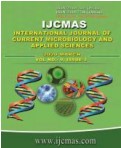


 National Academy of Agricultural Sciences (NAAS)
National Academy of Agricultural Sciences (NAAS)

|
PRINT ISSN : 2319-7692
Online ISSN : 2319-7706 Issues : 12 per year Publisher : Excellent Publishers Email : editorijcmas@gmail.com / submit@ijcmas.com Editor-in-chief: Dr.M.Prakash Index Copernicus ICV 2018: 95.39 NAAS RATING 2020: 5.38 |
An investigation was conducted in oil palm sole crop and oil palm + cocoa cropping systems to study microbial diversity along with enzyme activities and understand soil carbon dynamics in oil palm based cropping system. Ten mature oil palm plantations (five each in oil palm sole crop and oil palm + cocoa) planted with Tenera hybrids with a spacing of 9 X 9 X 9 m in a triangular system were selected for the study. Cocoa var. Forastero is cultivated as an intercrop in oil palm plantations at 4.5 X 4.5 m spacing. Recommended package of practices for oil palm and cocoa cultivation were followed. Soil samples were collected in the two cropping systems (oil palm sole crop and oil palm + cocoa) at three consecutive depths from surface (0-15, 15-30 & 30-60 cm) and five distances from palm base (1, 2, 3, 4 & 5 meters) during the three seasons (summer, winter & rainy). The collected samples of soil were evaluated for soil carbon (C) dynamics viz., organic carbon (OC), potassium permanganate extractable C, readily mineralizable C, acid hydrolysable C, soluble C and microbial biomass C. Studies on soil carbon dynamics indicated that all the organic carbon fractions of two cropping systems varied significantly and highest values were recorded under oil palm + cocoa system. Higher carbon fractions were observed in summer, while lower fractions were seen during winter and rainy periods. Significant differences in soil carbon fractions were observed among three soil layers viz., 0 to 15, 15 to 30 & 30 to 60 cm. All the carbon fractions decreased from surface to bottom soil layers. A linear increment in soil carbon fractions was observed with increase in distance from palm base.
 |
 |
 |
 |
 |